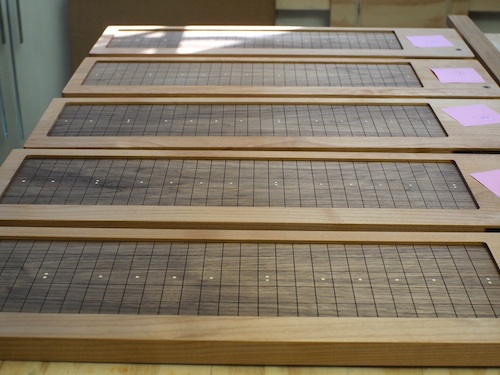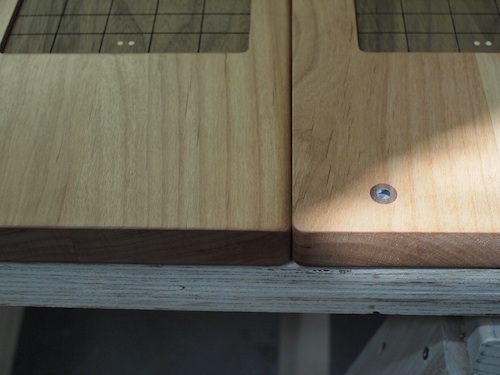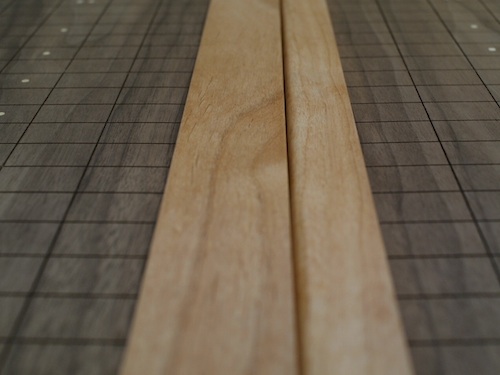randy's Recent Posts
Marking a big day in a project that has been over three years in the making, I just gave the first ten Soundplanes to a UPS driver. They've all been play tested, and I know more than ever that they're instruments with amazing expressive potential. I can't wait to hear what their owners do with them. And to spend some time playing mine.
(click images for closeups)
Hi Bob,
Good to hear from you. Your list seems correct, all these quantities come out as signals in the Aalto for Soundplane pre-beta I sent.
The Max example patch here in the forums should show the OSC data. I'll see what I can do to polish it up and add a Max MIDI patch in the next day or two.
-Randy
Thanks for the good report-- others have reported this and I am working on a fix for 1.3.
Hey there. It's two more midi CC outputs . because I want to keep the UI simple and not take any more space, they are set to the channels n+1 and n+2 where n is the "mod cc" channel set by the dial.
In short, lots more MIDI control!
Makes sense. Thanks for the suggestion.
My goodness, what exciting noise! There's an Aalto Soundcloud group too, often with some cool stuff in it.
Os of Expert Sleepers sent out this informative video this morning, showing how to use the Soundplane with the new OSC features in Silent Way version 2. This setup is the way to go for anyone who wants to play voltage controlled instruments using the Soundplane. OSC provides direct control over the envelope of each voice, so the player can articulate each note independently as you see here. Analog sounds with next-level control.
Expert Sleepers Silent Way and Madrona Labs Soundplane from Andrew Ostler on Vimeo.
Shipping the Soundplane has been, undoubtedly, the most difficult and the most risky thing I've done with my work life. And now that some people have their instruments, it's turning out to be the most rewarding.

When I see reactions like this, I feel like people are actually getting what I set out to do, and that I might have some company out on this long limb after all. And so it makes me want to get more work done for the brand new community of Soundplane owners—I have more instruments to deliver, and a ways to go in making the software experience live up to what the hardware offers.
Another thing I need to do, though, is have a party to celebrate the occasion of this audacious project actually shipping, and to offer a beverage and a big round of thanks to everyone who has helped get it here. Thanks to the music lovers at software design / development group Substantial, the party will take place at Substantial’s HQ in the heart of Seattle’s Capitol Hill. The address is 900 E Pine, Suite 202. We will be there from 7-10 pm on Wednesday, August 29. If you haven't tried a Soundplane yet, this will be a great chance to try one in a relaxed atmosphere. Hope to see you there.
Oh yes, there will be more synths.
The Library going away seems like part of a larger move at Apple towards explicit file management going away, and everything being saved transparently. To the extent that they can do this really well, I think it's good because computers should be more like appliances, most of the time.
but... what if I make more synths?
I am guessing you updated to Lion or newer? These systems hide the preset directories by default. You can search for "Lion hides Library folder" to get more info.
Still they would show up in Aalto's menu if they are in the right place. I can only guess at what's happening because it depends on where you saved and how you backed up. The default directories in /Library... and ~/Library... , but you can save patches anywhere you like.
The voices indicator is the same---the lights disappear when they get so small, is all. The patcher outputs are translucent as placeholders while I'm working on them.
As we move into late Summer, the Soundplane has moved from work-in-progress to shipping product, and more and more people are finding out about it. I've been refining the software that converts raw Soundplane data into expressive touches, and releasing updates every week or so. Last week I added plug-and-play support for the Kyma sound design environment, and bar|none used it to make a video:
Resonations from bar|none on Vimeo.
Thanks in part to bar|none’s video posted over on Create Digital Music yesterday, I've gotten quite a few requests about Soundplane availability.
I am currently waiting on some additional parts that were needed to complete the first batch of 30 instruments. I expect to get these, and ship all the remaining instruments by mid-September. At that point I'll be able to do all the math on timing and pricing for the next batch.
Meanwhile, if you'd like to get on the wait list for this next batch, let me know. I am currently just keeping a list of interested people in order with no obligation. At some point a prepayment will be required to hold an instrument.
The price will be slightly higher than the prerelease price of $1,695, but less than $2,000.
To see what else is possible over OSC (Open Sound Control), check out this video of Jordan Rudess using an early version of Aalto for Soundplane.
Stay tuned for news on the Aalto 1.3 release with Soundplane support and other goodies, coming soon!
Details to follow in mid-September. Best. r.
Sure, I can hook this up in the morning. There's even a label change from "mod" to "mod cc#" in your honor.
Yup, as you discovered, the maximum folder depth in there is 1.
I don't know what's going on here, automation in Live should work well.
What disappears exactly? You mean the cables in Aalto's patcher?
Is this with a demo version of Aalto?
I just experimented with proximity a bit and can offer some advice. If you go to the Expert page and turn smoothing all the way down, and then template up high, past 0.5 or so, then you can get two touches closer together. Adjacent keys should work with these settings, if long as the touches are as far from each other as possible.
The smoothing and the template matching are two different ways of rejecting noise, so by doing this you are increasing the noise level. But the recent instruments are quiet, so the tradeoff may be worth it to you.
Plug and play Kyma support is in. Makes me wish I had a Kyma! How did I test it? We sent a Soundplane to Symbolic Sound in Champaign. Thanks Ben and Kurt and Carla!
I'm confident I can do better with adjacent keys. I have a few other things fighting for my attention now, like Aalto for Soundplane. When the software settles down a little, I can work on the proximity issue.
While designing the surface I thought long and hard about how many key divisions to make. Right now there are two sensors under each key horizontally. I could have had three under each, making adjacent touches possible right away, with fewer keys overall. But I opted for more keys and what seemed like a comfortable key size for playing melodic lines.
The fingering workarounds I describe in the manual, and the fact of the Continuum having the same issue, helped me decide the current setup was the right balance.
Hi all,
Another client upload will be coming later today. Feel free to chime in on this topic with questions and feature requests.
Here are some features that I intend to release in the next couple of days:
[editing with status]
- velocity sensitivity for MIDI (reworking)
- MIDI pitch bend control (done)
- MIDI retrigger option for slides (done)
- note quantize with adjustable filtered snap time (done)
- select different key->note maps (done)
- auto state save from app
Some more features should also come very soon:
- store multiple states as presets
- MIDI selector for single channel / multiple channels
- UI for making key->note maps
- both note zones and controller zones
And fairly soon:
- built-in test sound
- select alternate carrier groups
- secret new axis of control
The 1.3 update will be free.
Hi Ben,
Depending on the way you have pitches arranged on the keyboard, you can get half-steps by either playing adjacent columns at different y positions (with continuous x pitch) or separated by a row (with rows in fourths).
In theory it will be possible to do a better job with adjacent keys in the future, with smarter software. But for now, it's a limitation of the instrument. Simultaneous touches need to be separated by a single key, or with careful playing, one step diagonally from each other.
Sorry you are frustrated, but I don't have the time or the money to work on a Windows version right now. I have plans to do so later, so stay tuned, if you like.
I haven't had time to try Ardour. Hopefully someone else here can help.
You can also try the VST version of Aalto if the AU is not working.
im sure this has been requested before
actually not...
but can aaltos sequencer delay dials be fine tunable (instead of just 1.0 1.5 2.0 2.5... 1.0 1.1 1.2 1.3 or even more fine than that)
I can probably do that though.
I'm not too interested in making the sequencer or envelopes much more complicated with other modes and such. I'm more likely to add these to a future, fully modular, product.
do you feel like the initial soundplane release has raised sufficient funds to continue making them?
Yes it has.
I'll have some new automation features in the 1.3 update coming later this month.
Hey, there's now a menu with two pitch modes. This and the other changes are noted in the release notes up above.
Maybe separate OSC and MIDI rate controls would be easiest? Although I can see an argument for wanting some kinds of data but not others.
I'm going to take a couple of days off to work on Aalto / Soundplanes, will think this over.
This is not something I am looking at doing anytime soon, but I do appreciate the info.


